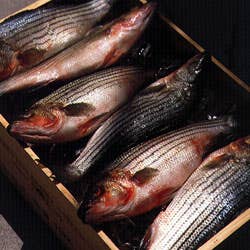
Striped Bass—Wild or Farmed?
Not all striped bass are alike: farmed fish is more consistent in taste than the ocean-going bass, but the latter is more robust.
Striped bass is part of a seagoing family that includes grouper, sea bass, loup de mer, and various freshwater fish. Just as there are distinctions between stripers and their freshwater cousins, there are definite differences between farm-raised striped bass and those caught wild from the ocean. What's the difference? The farmed striped bass is actually a naturally occurring hybrid, a cross of white bass and striped bass that developed spontaneously in the 1930s, when someone introduced an ocean striper into a freshwater pond. Like wild bass, the hybrids can live in both fresh and salt water.
A farmed fish is rounder than one caught in the wild, with less of a torpedo shape, and has broken stripes instead of solid ones. The farmed bass rarely grows beyond three pounds and is usually harvested when it reaches a pound and a half. Quality farm-raised fish are fed on a custom diet with high proportions of fish meal and fish oil—designed to emulate as closely as possible the diet eaten by the wild striper.
Not all farmed striped bass are alike, however. Better farms raise their fish in large tanks with water filtered hourly; the filtration produces a current that encourages the fish to swim vigorously—they cover some 25 miles a day—rather than floating around in a leisurely fashion. This exercise gives the bass firmer, flakier flesh.
Some diners find wild striped bass to be stronger in flavor than its farm-raised cousin. We think of it another way: Ocean-going bass is not as consistent in taste as the farmed fish, but it is more robust. After all, it's wild—and that's the attraction.
Keep Reading
Continue to Next Story










